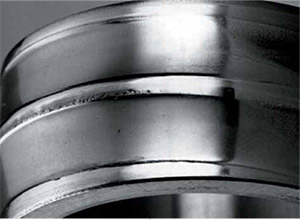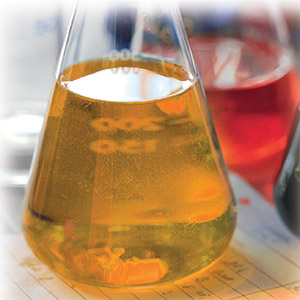Ask the Experts
“Are there any warning signs of when a bearing is about to fail?”
 Think of a bearing failure as happening in four stages. During the frst stage (or earliest detectable point using vibration analysis), the signals will appear in frequency bands around 250 to 350 kilohertz (KHz). In the second stage, a signal around 500 to 2,000 hertz (its natural frequency) will begin to ring.
Think of a bearing failure as happening in four stages. During the frst stage (or earliest detectable point using vibration analysis), the signals will appear in frequency bands around 250 to 350 kilohertz (KHz). In the second stage, a signal around 500 to 2,000 hertz (its natural frequency) will begin to ring.
At the onset of the third stage, the harmonics of the fundamental frequency will start to be very apparent. Defects in the races are now obvious and will be visible on vibration analysis of the noise signal. At this point, there will also be a signifcant temperature increase.
During the fourth stage, there will be very high vibration. The fundamental frequency and harmonics begin to decrease as the random ultrasonic noise is boosted. Temperatures will start to skyrocket as the bearing selfdestructs. So, the short answer is yes. There are defnitely warning signs of a bearing about to fail. The real question is, “Do you know what to look for?” The most popular technologies today for bearing monitoring are vibration analysis, oil analysis, ultrasonics and thermography. You can use these tools to compare current states to historical data and accurately assess the remaining life of the bearing.
Vibration analysis and oil analysis are considered the best at predicting a failure but are not always the most cost-effective. Bearing manufacturers have long known of the relationship between bearing life and temperature. They even have formulas that work very well at calculating safe operating temperatures. These formulas and calculators show that once a bearing starts operating outside its ideal temperature range, its life will begin to degrade at an accelerated rate. Keep in mind that for every 15 degrees C above 70 degrees C that the base oil operates, its life is more than halved.
Considering this, why is thermography not a more popular method for bearing life prediction? The monitoring of temperatures is not always considered reliable because of the sheer amount of variables that contribute to the heat generation. Ambient temperature, friction, speed variability, load and runtime all have an effect on the temperature that will be measured.
Friction is the variable you should be the most concerned with if trying to predict a failure, but how do you separate it from all the others? If you could account for all the variables accurately, the increases you would get in operating temperature could be a great indicator of an impending failure. Perhaps the cheapest and easiest way to spot a bearing failure is to use a non-contact infrared thermometer. The caveat is that you must always account for the other variables as well.
“How important is the kinematic viscosity at 100 degrees C for a vacuum pump oil?”
 Viscosity is the most important physical property of a lubricant. Whether you are looking at the viscosity at the standard 40 degrees C or at 100 degrees C, it is the viscosity at the machine’s operating temperature that is critical to understand. Most bearing temperatures are hotter than 40 degrees C (104 degrees F) at the core, which is where the temperature should be analyzed to match the correct viscosity for the application.
Viscosity is the most important physical property of a lubricant. Whether you are looking at the viscosity at the standard 40 degrees C or at 100 degrees C, it is the viscosity at the machine’s operating temperature that is critical to understand. Most bearing temperatures are hotter than 40 degrees C (104 degrees F) at the core, which is where the temperature should be analyzed to match the correct viscosity for the application.
Vacuum pumps stress oil in a variety of different ways. Aside from the operating temperature, contamination is prevalent if these machines are not properly set up to exclude the ingress of contaminants. Also, the gas being processed has a huge impact not only on the viscosity but also on the lifespan of the oil in service. Process gases can reduce the oil’s viscosity, raise the acid number, increase the moisture level and lead to short lubricant life and low oxidative stability.
Most lubricant manufacturers will provide the viscosity for their products at 40 degrees C and 100 degrees C. The amount of change in the viscosity in relation to the temperature is known as the viscosity index of the lubricant. The viscosity index is most often reported in the technical data sheet of the candidate oil. The higher the viscosity index value, the less the viscosity changes with a change in temperature. This is a crucial factor to consider when looking to switch to a different type or brand of oil.
Kinematic viscosity is the measurement of a fluid’s resistance to flow due to the effects of gravity. It is the viscosity that most people are accustomed to in terms of how thick a fluid is. This will be one of the most noted changes as the oil is heated, the viscosity drops and the oil flows more readily. For all tribosystems, the oil’s ability to flow and support loads is what protects the component from surface degradation and ultimately the loss of usefulness and failure of the machine.
The viscosity at 100 degrees C is critical, not just for vacuum pumps but for all machines. It is important to understand the viscosity requirements of the bearings or gearsets at the operating temperatures and to ensure that they are being met by the lubricant in use. By verifying that the viscosity is appropriate, you will be generating less wear and prolonging the life of your machines.
If you have a question for one of Noria’s experts, email it to editor@noria.com.
